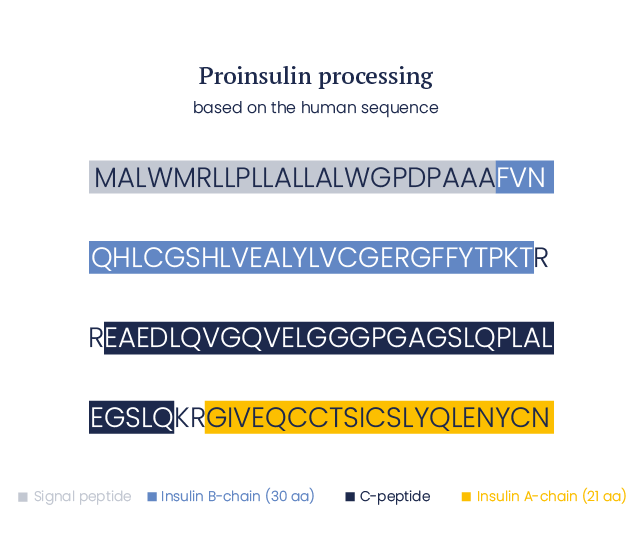C-Peptide
C-peptide and insulin
Equimolar amounts of C-peptide and insulin are stored in secretory granules of the pancreatic beta cells and both are eventually released into the bloodstream. Whereas insulin is metabolized quickly from circulation, C-peptide exhibits a slow turnover rate (>30 minutes). The measurement of C-peptide blood serum levels is an important test for the β-cell function.
C-peptide has its own bioactive effects on microvascular blood flow and tissue health.
At nanomolar concentration range, it binds specifically to cell surfaces, most likely to a G protein-coupled surface receptor and activates Ca2+ dependent intracellular signaling pathways.
Pro-insulin processing
C-Peptide (connecting peptide) is a short peptide released from the proinsulin precursor together with insulin (A and B chains).
In most species (human, rat, dog…), C-Peptide corresponds to amino acids 57 to 87 of proinsulin.
In rats, 2 proinsulin isoforms were identified, differing by two amino acids in the C-Peptide part (C-Peptide-1 and C-Peptide-2).
Proinsulin C-Peptide is the sequence of the C Peptide as it exists within proinsulin (amino acids 55 to 89 in human; 55 to 87 in pig).
References
- Gross, D. et al. J. Biol. Chem. 264, 21486 (1989)
- Wahren, J. et al. Am. J. Physiol. Endocrinol. Metab 278, E759 (2000)
- Wahren, J. and H. Jornvall, Diabetes Metab Res. Rev. 19, 5 (2003)
